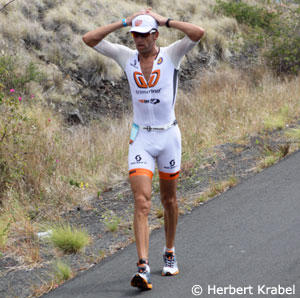
Imagine an Ironman, and you’re in it. You’ve finished the swim and the bike, and you’re long into the run. You’re not having your best day. You competitors have long since left you behind. You’re not competing for a spot. Now it’s just you.
It’s late in the day, evening is coming on, and any sort of power or pace or energy was exhausted much earlier. Shuffling is the best you can do. It’s just putting one foot in front of the other now.
That’s Mark Covert’s running style when he begins his daily run early each morning.
Daily run? How many days a week is that? Seven. Yeah, but, he takes a day off every now and then. Right? No. Except when he gets sick or injured. Yes? Nope. Today he’s running in a t-shirt. It says, Every Damn Day.
Covert was on a Fullerton State cross country team that was, more than 40 years ago, Division II NCAA champions. That team was legendary for its hard, hard work, and Covert was the ring leader.
He’s used to his teams winning. Prior to Fullerton State Covert ran community college track and cross country at Los Angeles Valley College. A lot of his work ethic as a runner came from that latter team’s coach László Tábori, Olympian, third man ever to break the 4-minute mile, former 1500m world record holder. Under Tábori’s tutelage Covert set a national community college record of 28:53 for 6 miles. That record still stands almost 45 years after it was set. It is not likely to be broken because that distance is not run anymore and, if it was, who among today's community collegians is going to break it?

Jon Sutherland was a teammate of Covert’s at Fullerton State. Sutherland is now coach at Notre Dame High School in Sherman Oaks, outside of Los Angeles. Covert tells the story of when “Sutherland asked me a couple of years ago to tell his kids about training. ‘Whatever Jon’s telling you to do,’ I said, ‘you’re not doing enough. You’re not doing enough.’
“I came from a different era,” continues Covert, “when miles were king, and we ran a lot. A whole lot. And we ran a lot of it hard. ‘To all those who’re just starting the sport,’” he says, “’You’re not going to break. You can do it. You can probably do more work.’”
When Covert admonishes high school students to do more, and that “you’re not going to break,” he’s not telling the entire truth. Mark Covert is not going to run tomorrow. It’s not because he doesn’t want to. It’s because he can’t. He’s broken.

His miles have finally caught up to him. But it took awhile. Tomorrow will be the first day he has not run since July 22, 1968. Today was the last day of The Streak and I was there to run his last, tortured mile with him. (I and hundreds of other people who've been Streak followers and admirers).
This is not a wimpy streak. Covert has averaged about 9 miles a day during that time, which began right after graduating high school. He’s 62 years old.
Covert was one of the original high-mileage runners, along with Gerry Lindgren and England’s Dave Bedford. Mark Covert would routinely run 200-mile weeks, one reason his daily average during the streak is so impressive.
Jon Sutherland was there on Covert’s last day of The Streak to honor him, as were several other members of his cross country teams from Burbank high school, L.A. Valley College, and Fullerton State. As were runners from several high school cross country teams.

Covert still loves running – he's the longtime track and XC coach for Antelope Valley College in Lancaster, California – and maintains he is not done running. He's just not running "tomorrow." He talks about reconstructive surgery for his feet. This or perhaps other therapies and helps of which Covert has never availed himself may be of benefit.
Covert is the first-ever runner to cross a finish line in Nikes, while running a 2:23:35 at the 1972 Olympic marathon trials, finishing 7th. He runs today in throwback support-free Nike lightweight trainers that would not typically be indicated for the severe over-pronater he is.
Until he's whole enough for running regularly again – assuming that day does arrive – he’s taken up cycling, so he is not done punishing himself and others.
The Streak lasted 45 years to the day. That is 16,436 consecutive days of running, 149,651 miles, that's 9.1 miles a day on average, 63 miles per week, 276 per month.
The Streak spanned 9 presidendial administrations beginning with the Lyndon Johnson presidency. It survived a broken foot, a knee surgery, a shoulder surgery, a kidney stone.
Mark Covert logged about 10,000 miles as a runner before The Streak, so, Covert's just a few hundred miles away from 160,000 miles lifetime.


